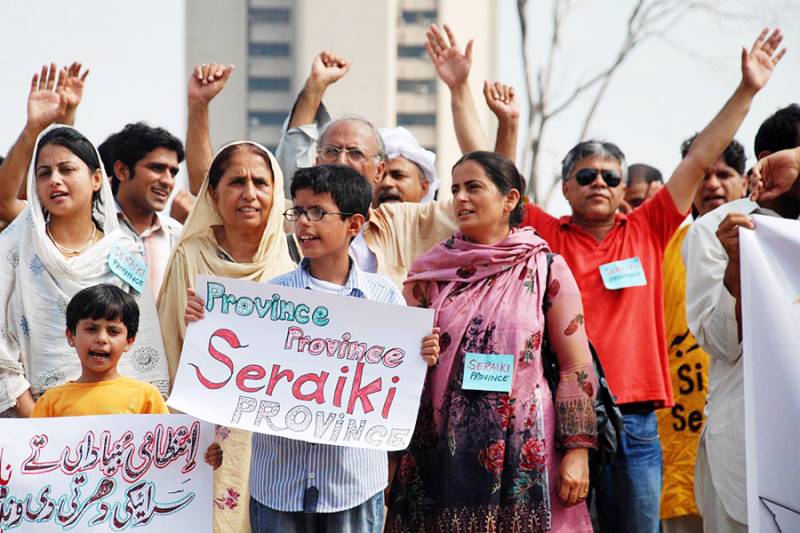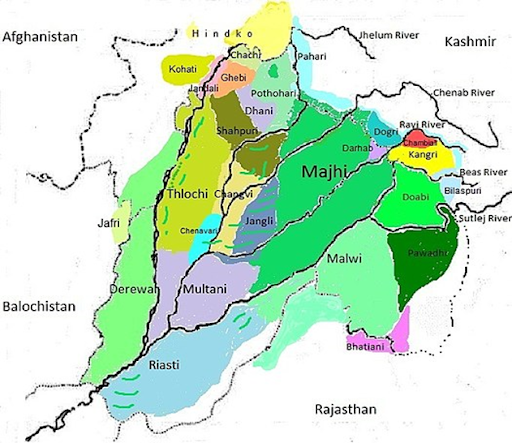
The demand for the new province for the people of South Punjab is yet to be materialised. Before the 2018 elections, Pakistan Tehreek-e-Insaf (PTI) invited the people of the region to its fold by promising to carve out a new province within hundred days after coming into power.
Consequently, the electable from South Punjab joined PTI. I still remember the days when Seraiki activists arranged a rally in Islamabad to commemorate their struggle that to them had brought fruit. One of the speakers in the rally while congratulating the crowd said, "We have achieved our goal and now we must think of post-province strategies.” But, unfortunately, it all ended in a fiasco.
Our Seraiki activist friends de-mark the boundary around those areas where the present Seraiki dialect is spoken. The language spoken in the plains of Dera Ghazi Khan, in Multan and its suburbs and in Bahawalpur division had its present nomenclature ‘Seraiki ‘in 1962 with the consensus of the intellectuals of the aforementioned areas in a conference at Multan. Before the consensus, the language was differentiated with different names. At some places, it was called Multani, Riasti, and Lehandi and in some other places, it was called Jangli and Shahjahani. Recently, Dr. Ashfaq Ahmed in his online conversation with our Sindhi friends claimed that Siriaki was a 'lingua franca' of the business route from the deltas of Thataa to the upstream of the river Sindh.
Once, coming from Rahim Yar Khan, I met Charles. He was an official at the church of Rahim Yar Khan. To my surprise, he was translating the Bible in Seraiki language. You can watch his effort on YouTube where you find a movie named The Jesus Film, dubbed in Siraiki language. Dr. Ashfaq endorsed Charles when claiming that Seraiki is a lingua franca at the left bank of the river Sindh.
In the map below, we find demographic segmentation that only in Lahore and in its vicinity Majhi (Gurmukhi) is spoken. Whereas, in the downstream of the Punjab Siriaki is spoken with its different dialects; Jangli, Multani, and Riasti and in Doaba Jhangvi is spoken. Even some of the scholars are of the view that Pothari is also a dialect of Siriaki but so far it is not substantiated.

It is also interesting to know that in Qandahar and in its vicinities, Siraiki was spoken by Hindu businessmen and the language is still spoken in many parts of Qandahar even today. Siraiki has some distinct sounds which might have its origin in Harappan civilization. Siriaki linguists have done enormous work to explore its distinction from other languages spoken in Punjab.
In his book, The people of Pakistan, Yuri V Gankovsky also termed the people of Sirro, the Northern Sindh as "Siraiki”. The noted Pakistani archeologist Prof. Hassan Dani corresponded with this view who calls Seraiki, 'a corruption of Sauvyria, now Sehwan Sharif'. It was a province of Sindh during the Brahman dynasty. (Khan, Hussain. 2013). It is also believed that Siraiki were the immigrants to Sindh from Bahawalpur and upper Sindh and Prof. Hamida Khuro also propounded the same view. The people of Northern Sindh when migrated to the upper Punjab were called Jats or Baluch but were not distinguished as Siraiki.
When in the 1960s the English constructed canals the people of upper Punjab were settled in Bahawalpur state. They called themselves Punjabi to distinguish themselves from the natives of the region. By holding the irrigated lands, offered to them officially, they started exerting influence on the natives who were called 'sluggish and illiterate' by Abadkars (the settlers).
This identity given to natives (sluggish, illiterate) became the part of the ideology of the state of Pakistan mostly dominated by the bureaucracy; hailing from upper Punjab. Interestingly, the natives of the right bank and the left bank of Sutlej, divided in different bars, and Neeli bar is prominent, are called Jangli-s (uncultured) by Abadkars and all of them are Seraiki speaking people. “The Seraiki were also colonised during English Raj”, a Seraiki activist claimed.
Consequently, the industrialization started in upper Punjab. Hamza Alvi highlighted, in a number of his articles, the social formation and class alignment as the ‘colonial mode of production,’ that accelerated the economic disparity and power politics; ignoring the areas that English considered non-productive.
In present-day Punjab, which is politically dominated by Majhis, was once confined to Lahore and its suburbs, that later exerted their influence in Ranjeet Singh's reign: the natives of Punjab are subjugated economically. Owing to industrialisation, the skilled labour had an opportunity to groom itself but the natives remained in labour roles. If you have a glimpse of the data of labour working in Saudi Arabia and the other Gulf States you find brick labor from the Seraiki belt or the natives of Punjab, as the skilled labour. Mostly, Punjabi speaking people are employed in the eastern region of Saudi Arabia. That area caters to the labor of Aramco.
My contest is that the natives come forward to claim themselves the real Punjabis to assert themselves and their genuine rights that are snubbed by the exploiters. And they claim themselves as the real people of Punjab.
My Seraiki activist friends who just exert their efforts on the lower part of Southern Punjab as it is today instead of demanding, peacefully, of course, their rights to education, health, and their due share in the National Finance Commission (NFC) award that ought to be spent on natives of the land. It doesn’t mean I’m against the Southern Punjab province but to me ignoring the Sargodha division will help upper Punjab get a bigger share in the NFC award. One shouldn’t forget that the NFC award is a reality and the shares need to revisit and non can reverse the 18th amendment as claimed by the incumbent government of Imran Khan.
Consequently, the electable from South Punjab joined PTI. I still remember the days when Seraiki activists arranged a rally in Islamabad to commemorate their struggle that to them had brought fruit. One of the speakers in the rally while congratulating the crowd said, "We have achieved our goal and now we must think of post-province strategies.” But, unfortunately, it all ended in a fiasco.
Our Seraiki activist friends de-mark the boundary around those areas where the present Seraiki dialect is spoken. The language spoken in the plains of Dera Ghazi Khan, in Multan and its suburbs and in Bahawalpur division had its present nomenclature ‘Seraiki ‘in 1962 with the consensus of the intellectuals of the aforementioned areas in a conference at Multan. Before the consensus, the language was differentiated with different names. At some places, it was called Multani, Riasti, and Lehandi and in some other places, it was called Jangli and Shahjahani. Recently, Dr. Ashfaq Ahmed in his online conversation with our Sindhi friends claimed that Siriaki was a 'lingua franca' of the business route from the deltas of Thataa to the upstream of the river Sindh.
Once, coming from Rahim Yar Khan, I met Charles. He was an official at the church of Rahim Yar Khan. To my surprise, he was translating the Bible in Seraiki language. You can watch his effort on YouTube where you find a movie named The Jesus Film, dubbed in Siraiki language. Dr. Ashfaq endorsed Charles when claiming that Seraiki is a lingua franca at the left bank of the river Sindh.
In the map below, we find demographic segmentation that only in Lahore and in its vicinity Majhi (Gurmukhi) is spoken. Whereas, in the downstream of the Punjab Siriaki is spoken with its different dialects; Jangli, Multani, and Riasti and in Doaba Jhangvi is spoken. Even some of the scholars are of the view that Pothari is also a dialect of Siriaki but so far it is not substantiated.

It is also interesting to know that in Qandahar and in its vicinities, Siraiki was spoken by Hindu businessmen and the language is still spoken in many parts of Qandahar even today. Siraiki has some distinct sounds which might have its origin in Harappan civilization. Siriaki linguists have done enormous work to explore its distinction from other languages spoken in Punjab.
In his book, The people of Pakistan, Yuri V Gankovsky also termed the people of Sirro, the Northern Sindh as "Siraiki”. The noted Pakistani archeologist Prof. Hassan Dani corresponded with this view who calls Seraiki, 'a corruption of Sauvyria, now Sehwan Sharif'. It was a province of Sindh during the Brahman dynasty. (Khan, Hussain. 2013). It is also believed that Siraiki were the immigrants to Sindh from Bahawalpur and upper Sindh and Prof. Hamida Khuro also propounded the same view. The people of Northern Sindh when migrated to the upper Punjab were called Jats or Baluch but were not distinguished as Siraiki.
When in the 1960s the English constructed canals the people of upper Punjab were settled in Bahawalpur state. They called themselves Punjabi to distinguish themselves from the natives of the region. By holding the irrigated lands, offered to them officially, they started exerting influence on the natives who were called 'sluggish and illiterate' by Abadkars (the settlers).
This identity given to natives (sluggish, illiterate) became the part of the ideology of the state of Pakistan mostly dominated by the bureaucracy; hailing from upper Punjab. Interestingly, the natives of the right bank and the left bank of Sutlej, divided in different bars, and Neeli bar is prominent, are called Jangli-s (uncultured) by Abadkars and all of them are Seraiki speaking people. “The Seraiki were also colonised during English Raj”, a Seraiki activist claimed.
Consequently, the industrialization started in upper Punjab. Hamza Alvi highlighted, in a number of his articles, the social formation and class alignment as the ‘colonial mode of production,’ that accelerated the economic disparity and power politics; ignoring the areas that English considered non-productive.
In present-day Punjab, which is politically dominated by Majhis, was once confined to Lahore and its suburbs, that later exerted their influence in Ranjeet Singh's reign: the natives of Punjab are subjugated economically. Owing to industrialisation, the skilled labour had an opportunity to groom itself but the natives remained in labour roles. If you have a glimpse of the data of labour working in Saudi Arabia and the other Gulf States you find brick labor from the Seraiki belt or the natives of Punjab, as the skilled labour. Mostly, Punjabi speaking people are employed in the eastern region of Saudi Arabia. That area caters to the labor of Aramco.
My contest is that the natives come forward to claim themselves the real Punjabis to assert themselves and their genuine rights that are snubbed by the exploiters. And they claim themselves as the real people of Punjab.
My Seraiki activist friends who just exert their efforts on the lower part of Southern Punjab as it is today instead of demanding, peacefully, of course, their rights to education, health, and their due share in the National Finance Commission (NFC) award that ought to be spent on natives of the land. It doesn’t mean I’m against the Southern Punjab province but to me ignoring the Sargodha division will help upper Punjab get a bigger share in the NFC award. One shouldn’t forget that the NFC award is a reality and the shares need to revisit and non can reverse the 18th amendment as claimed by the incumbent government of Imran Khan.
